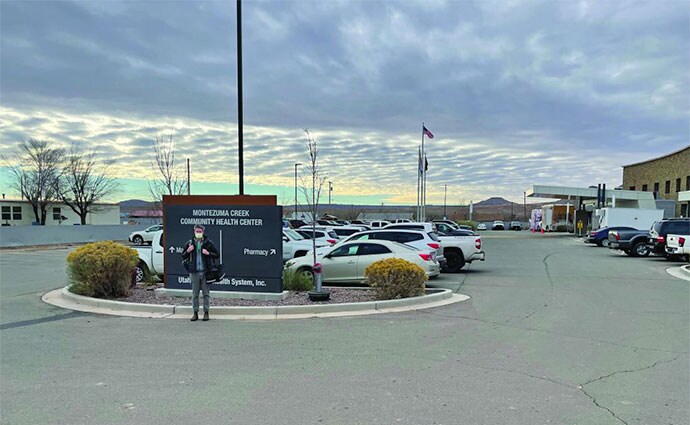As a proud member of the Oglala Lakota Nation from the Pine Ridge Indian Reservation in southwestern South Dakota, Drew Hicks grew up with limited access to basic health care, let alone the luxury of scheduling an appointment with a dermatologist or another medical specialist.
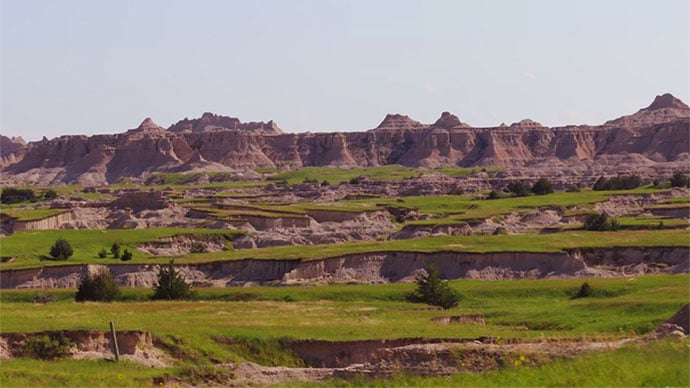
A portion of Badlands National Park is located near the Hicks family ranch in Pine Ridge, S.D.
The area – once home to the Lakota war leader Crazy Horse – encompasses nearly 47,000 residents scattered over about 2.2 million acres, larger than the size of Rhode Island, with land marked by rolling mixed grass prairie, sandhills, and badlands. Some of the Oglala Lakota people live in substandard housing and lack regular access to food, running water, and refrigeration, not to mention cell phone and Internet service. "It's sparse," said Mr. Hicks, the son of Tribal ranchers who now is a 3rd-year medical student at the Mayo Clinic College of Medicine and Science in Rochester, Minn., and has an early interest in pursuing dermatology. "There is a lot of territory and not a lot of health care serving the population." From the Hicks home, the nearest place to receive health care is a family medicine practice in Martin, S.D. – about a 15-minute drive on gravel roads in the best of conditions, but in poor weather, it can be difficult, he said. "So, there are environmental challenges besides the limited number of health care providers."
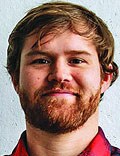
Drew Hicks
Challenges of health literacy and limited access to comprehensive health care at Pine Ridge and other American Indian (AI) and Alaska Native (AN) reservations have long-term consequences. "My own mom struggled to control her blood pressure for years and now has chronic kidney disease," Mr. Hicks said. "It's not an uncommon story. Diabetes on the reservation is a big issue." Then there's his father, who survived two bouts with melanoma that was diagnosed at an advanced stage. "I think about how that has impacted him, and wonder, had we had a dermatologist who serviced our area, would we have caught things sooner?" he said. "I feel there is so much room for impactful health care deliveries to communities like Pine Ridge." At the same time, he emphasized, "this isn't poverty porn. We're a resilient people. Any effort to engage with AIs or ANs should be from a perspective of a learner, having cultural humility, and seeking out community leaders to help lead you."
According to the 2020 Census, there are 574 federally recognized sovereign tribal nations in the United States and federal- and state-recognized American Indian reservations in 35 states. AI/AN people make up about 2.9% of the total U.S. population, or 9.7 million, and their life expectancy is an average of 4.4 years less, compared with the general population (a mean of 73.7 vs. 78.1 years, respectively). Because of limited access to dermatologic care in these areas, the risk for developing significant skin conditions and diseases that may go undetected for long stretches of time is increased.
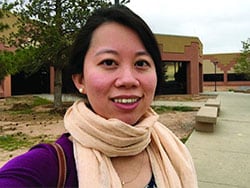
Lucinda Kohn, MD
"That can mean advanced skin cancers like basal cell carcinomas that have become larger than what you would see in a typical metropolitan population," said Lucinda Kohn, MD, assistant professor of dermatology in the Centers for American Indian and Alaska Native Health at the University of Colorado at Denver, Aurora, who spent part of her dermatology residency rotating at the Chinle (Ariz.) Service Unit, an Indian Health Service facility, in 2017 and now provides teledermatology and regular in-person dermatology care at that clinic. "The climate there is dry, so you can see bad eczema and dry skin. There's also a lot of acne and hidradenitis suppurativa. I think the acne and HS is due to the hyperglycemic index diet from the food deserts. Skin disease reflects the climate, the food desert, and the lack of close specialty care."
Acne scarring common
Some published evidence suggests that acne is more prevalent and severe in AI/AN individuals. In a survey of 158 AI/AN individuals with a mean age of 32 years, 79.1% reported a history of acne, 55.1% reported acne scarring, and 31% reported having active lesions. "Looking back on my experience in high school, I definitely see that in myself and in my peers," Mr. Hicks said. And, while there are limited published studies about the incidence of melanoma in this population, an analysis from 2006 found that the incidence was 3.1 per 100,000 between 2001 and 2005, which was an increase from 1.6 per 100,000 reported between 1992 and 2000.
There's a lot to unpack for dermatologists caring for the AI/AN population besides the raw health disparities: a long history of distrust between AI/AN people and the federal government, structural racism, geographic isolation, health literacy challenges, and high rates of poverty and unemployment. And while individuals from federally recognized tribes have a legal right to receive health care provided by the Indian Health Service, a component of the Department of Health & Human Services, the U.S. Government Accountability Office found that in 2017 per capita spending available to the IHS was $4,078, compared with $8,109 for Medicaid, $10,692 for the Veterans Health Administration, and $13,185 for Medicare.
"Everyone deserves healthy skin and good health," said Dr. Kohn, whose husband is AI and works in AI law. "Knowing that there are pockets of people who lack that access to care really bothers me. I think the American Indians are frequently overlooked. They're just not even counted for in certain surveys," she added, noting that categories are usually defined as Black, Hispanic, Asian, or White.
According to Dr. Kohn, who coauthored a chapter titled "Dermatology on American Indian and Alaska Native Reservations," for the 2021 book "Dermatology in Rural Settings", 70% of AIs live in urban areas, "so it's not just people who live on reservations, though the disparity is greatest there." To help deliver dermatologic care in the rural areas "where you're on tribal lands, you must partner with the tribes," she added. "You must get their permission, operate under their laws and regulations and their rules, learn the local customs, learn about the culture, learn the people, and learn their resources before you practice. That's the only ethical way to practice." This also means appreciating the fact that some AI/AN individuals may not understand what a dermatologist could do for them. "One of the bigger hurdles to overcome," she said, is educating the population that dermatologists can cure skin diseases and that there are good medications for treating the diseases.
Shortcomings of teledermatology
Some dermatologists perform teledermatology visits for tribes, often from an office located in a different time zone. "And, they don't have a sense of what resources are available for the people they're serving," Dr. Kohn said. "For example, if they diagnose a potential skin cancer on the face and say, 'you need a biopsy,' but the closest dermatologist is 4 hours away, is that really serving the patient? Or, if you tell a patient, 'I want you to go out and buy Vanicream for your skin,' but Vanicream costs $17 and the patient can't even afford to buy food, are you really doing them a service?"
In a survey-based study of 238 AI individuals that is scheduled to be published in late 2023, Dr. Kohn and colleagues asked respondents at two regional powwows in Denver if they would be open to teledermatology – either in their home or in a primary care clinic. Most respondents (70%) lived in urban areas, the rest in rural settings. Nearly half of respondents (42%) "did not want to do teledermatology, even though they couldn't access in-person dermatology," Dr. Kohn said. "So, for people who think teledermatology is the answer [to improving access], the respondents to our survey weren't interested in pursuing that as a solution. I was surprised by that." When the researchers broke down the responses by age, teenage respondents were even less interested in teledermatology than adults were. "I think there's something about having someone see you in person, knowing who you are," she said.
Partnerships with tribes
To foster more sustainable change in the delivery of skin care beyond remote teledermatology and periodic visits from volunteers, some dermatology residencies have established partnerships with tribes, including Massachusetts General Hospital's teaching partnership with the Rosebud Sioux tribe in Rosebud, S.D., and the University of Utah dermatology department's resident continuity clinic with Navajo Nation in Montezuma Creek, Utah. In 2016, officials from the Utah Navajo Health System reached out to the University of Utah's dermatology department to inquire about the potential for creating a teledermatology clinic to serve patients who receive primary care at the Montezuma Creek Community Health Center, located in Southeastern Utah on the northern tip of the Navajo Nation.
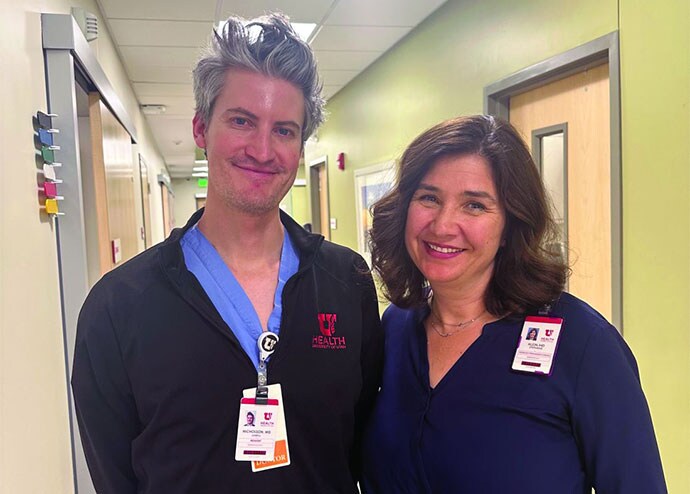
Stephanie Klein, MD (right), and Lowell Nicholson, MD (left)
Stephanie Klein, MD, associate professor of dermatology at the university, spearheaded the clinic's launch but soon encountered obstacles that ranged from not being able to visualize the patient's skin clearly on her computer screen to difficulty making a personal connection with patients despite help from Navajo translators. "It was hard to build a relationship," she said. A few years later, she drove down to meet with officials of the health system and posed the question: "What is the ideal thing you would want from dermatology?"
- 0
Credits:
Lead image: Tara Fanning
Image 1: Tara Fanning
Image 2: Drew Hicks
Image 3: Dr. Lucinda Kohn
Image 4: Dr. Stephanie Klein
Image 5: Dr. Stephanie Klein
© 2023 Frontline Medical Communications Inc.
Cite this: Dermatologic Care in Indian Country: Challenges, Opportunities - Medscape - Jul 21, 2023.

